The chilly winds of the autumn carrying the sweet scent of grapes whit them, all around the world thousands of agricultural workers prepare for the harvest. When we think of the fall we always think about time passing, falling leaves, and the shortness of the days. However, if we look beneath the surface, we may find interesting connections, and hearth warming traditions.
In this little post, i like to describe the different customs of different countries, regarding the celebrations of fall. I hope that the international students of our universtity recive the descripcion of this little part of their culture with open hearts.
Essencialy, if we look around the world, we can see that every culture has a different and unique relationship whit autumn. For some it’s the time of the harvest, and others celebrate the equinox. But the autumn celebration can be traced back for this two reasons. The celebration of the harvest of the autumn grain crops, and the equinox. So it’s not a surprise to see, that most of those celebrations are held in regions with four seasons. (Exept the jewish holidays.)
So now i like to show you around the customs of four different nations and their traditions. The anglo-saxon holiday of Thanksgiving and Halloween, beside that i will write about the jewish traditions, then the Chinese and Korean ones.
So at first let’s look around in the anglo-saxon world. At the beginning of this blog post i like to describe the American and Celtic traditions, regarding autumn.
Thanksgiving
Every year, at the last Thursday of november the americans celebrate the Thanksgiving day. The first, recorded Thanksgiving was in 1621. In Plymouth, Massachusetts the pilgrims and the native tribe of the Wampanoag came togather and shared a harvest meal with eacother.
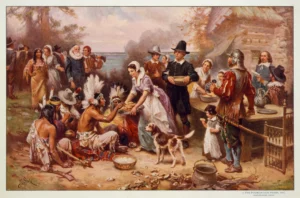 Until 1863 each state celebrated thanksgiving seperately, but then Abraham Lincoln, in the middle of the civil war, declared it a national holiday. Since then Thanksgiving is held on the last Thursday of november. At the 30’s President Franklin ‘D Roosevelt tried to push the date a week away, it was jokingly called Franksgiving, but two years later it was placed back to its original place. Thanksgiving is a controversial holiday, more or less. Among the Natives, many thinks its just an exuse and a show of, to pretend that the relationship was amicable, while in reality the relationship was hostile, with most of the Native tribes. A lot of Native people dont even celebrate this day. But to go back to 1621, and the pilgrims. They arrived at this point, a year ago to the shores of America, most of them died during the winter. But in the spring of 1621 they make it to land, and started to cultivate it, with the help of the natives. By november that year, the first corn harvest was ready. So then William Bradford, the gorvernor of the colony invited the Wampanoag tribe, to celebrate with them. The celebrations went on for 3 days, but for sure they didnt eat those pies and sweets that are so popular nowadays. They were out of sugar and flour by this time.
Until 1863 each state celebrated thanksgiving seperately, but then Abraham Lincoln, in the middle of the civil war, declared it a national holiday. Since then Thanksgiving is held on the last Thursday of november. At the 30’s President Franklin ‘D Roosevelt tried to push the date a week away, it was jokingly called Franksgiving, but two years later it was placed back to its original place. Thanksgiving is a controversial holiday, more or less. Among the Natives, many thinks its just an exuse and a show of, to pretend that the relationship was amicable, while in reality the relationship was hostile, with most of the Native tribes. A lot of Native people dont even celebrate this day. But to go back to 1621, and the pilgrims. They arrived at this point, a year ago to the shores of America, most of them died during the winter. But in the spring of 1621 they make it to land, and started to cultivate it, with the help of the natives. By november that year, the first corn harvest was ready. So then William Bradford, the gorvernor of the colony invited the Wampanoag tribe, to celebrate with them. The celebrations went on for 3 days, but for sure they didnt eat those pies and sweets that are so popular nowadays. They were out of sugar and flour by this time. 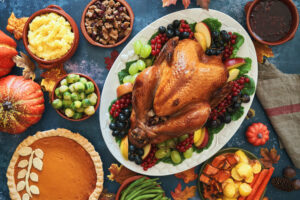 They most likely ate turkey and wild game with corn and vegetables and berries. The next Thanksgiving happened two years later, when they celebrated the end of a drougtht. After this the annual celebrations and thanksgivings spread accros the states. And as i mentioned before, it became a national holiday during the civil war, so they can commemorate the end of the civil war. And usualy they also remember their independence this day, not just on the independence day at summer. No one did as much for the holiday, to be aproved nationaly, then Sarah Josepha Hale, she was a New York based writer, and she made petitions and wrote letters to governors, congressmans and she also wrote noumerous articles about thanksgiving for 37 years. With this She rigthfully earned the nickname: Mother of Thanksgiving. And finally, after 37 years during the civil war Abraham Lincoln heard her cries, and made Thanksgiving a national holiday, to remeber those who had falled during the war, and gave thanks for those who returned. Since then, at the last Thursday of november, countles americans are gathering around the Thanksgiving table. But these days, the holiday almost lost its original religious meaning, and the focus shifted to family and foods instead. The official food of the holiday is the Turkey. This bird become synonymous with Thanksgiving. The president pardons a Turkey every year and it can live it’s life on a farm. But the other two birds are not as lucky. In New York some people wear funny costumes not only on Halloween but on this day as well. The countdown for Christmas is also starting on this day.
They most likely ate turkey and wild game with corn and vegetables and berries. The next Thanksgiving happened two years later, when they celebrated the end of a drougtht. After this the annual celebrations and thanksgivings spread accros the states. And as i mentioned before, it became a national holiday during the civil war, so they can commemorate the end of the civil war. And usualy they also remember their independence this day, not just on the independence day at summer. No one did as much for the holiday, to be aproved nationaly, then Sarah Josepha Hale, she was a New York based writer, and she made petitions and wrote letters to governors, congressmans and she also wrote noumerous articles about thanksgiving for 37 years. With this She rigthfully earned the nickname: Mother of Thanksgiving. And finally, after 37 years during the civil war Abraham Lincoln heard her cries, and made Thanksgiving a national holiday, to remeber those who had falled during the war, and gave thanks for those who returned. Since then, at the last Thursday of november, countles americans are gathering around the Thanksgiving table. But these days, the holiday almost lost its original religious meaning, and the focus shifted to family and foods instead. The official food of the holiday is the Turkey. This bird become synonymous with Thanksgiving. The president pardons a Turkey every year and it can live it’s life on a farm. But the other two birds are not as lucky. In New York some people wear funny costumes not only on Halloween but on this day as well. The countdown for Christmas is also starting on this day.
Halloween
Now i like to write about the Halloween and the All Saints day traditions. October and november is also the time of the celtic new year. During this time there was 3-4 celtics holiday. One for the harvest, one for the new year, and for the equnox. But we have so few sources that its realy hard to tell that which are the original, and which are the catholics, christian mediveal custums.
 Halloween and All Saints’ Day can be traced back to the Celtic festival of Samhain. Samhain marked the end of the harvest season and was considered a precursor to winter. During this time, it was believed that the boundary between the spirit world and the living blurred. Huge bonfires were lit at the exact midpoint between the summer and winter solstices, and people would eat and drink. However, we have limited Roman-era and even fewer medieval Christian sources to rely on to determine precisely how the Celts celebrated, making it difficult to reconstruct their traditions.
Halloween and All Saints’ Day can be traced back to the Celtic festival of Samhain. Samhain marked the end of the harvest season and was considered a precursor to winter. During this time, it was believed that the boundary between the spirit world and the living blurred. Huge bonfires were lit at the exact midpoint between the summer and winter solstices, and people would eat and drink. However, we have limited Roman-era and even fewer medieval Christian sources to rely on to determine precisely how the Celts celebrated, making it difficult to reconstruct their traditions.
However, today’s Halloween and its customs can be traced back to medieval Christian and American traditions. In the Middle Ages, it was believed that the Celtic festival of Samhain provided an excellent opportunity to remember the deceased, leading to the establishment of All Saints’ Day on November 1st, dedicated to all saints. The practice of dressing up also originated in the Middle Ages.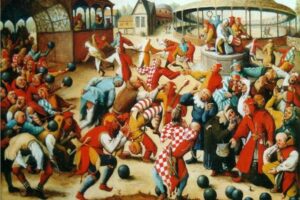 Most medieval celebrations included a costumed storyteller who would entertain the population as they traveled from village to village or even the city, often in exchange for some food or a small fee. While this costumed storytelling tradition gradually disappeared from many holidays, it interestingly persisted in Halloween. People dress in various spooky costumes to scare away evil creatures that are said to be active during this time. Another custom that emerged in Ireland involved less fortunate residents going from house to house, receiving specially made spicy baked goods or small change in exchange for praying for the deceased of the household. According to Catholic belief, these customs help reduce the time spent in purgatory. The three customs that are most prominent in Halloween today are dressing up, pumpkin carving, and trick-or-treating. Many people are hesitant to embrace this holiday because of the belief that malevolent creatures are present during this time, and some do not celebrate it at all, even in the United States. In Europe, there is reluctance to celebrate it, often due to its American origins, as the tradition of commemorating the deceased, like this was not common here. So, in summary, today’s Halloween is an American version of a Catholicized pagan festival.
Most medieval celebrations included a costumed storyteller who would entertain the population as they traveled from village to village or even the city, often in exchange for some food or a small fee. While this costumed storytelling tradition gradually disappeared from many holidays, it interestingly persisted in Halloween. People dress in various spooky costumes to scare away evil creatures that are said to be active during this time. Another custom that emerged in Ireland involved less fortunate residents going from house to house, receiving specially made spicy baked goods or small change in exchange for praying for the deceased of the household. According to Catholic belief, these customs help reduce the time spent in purgatory. The three customs that are most prominent in Halloween today are dressing up, pumpkin carving, and trick-or-treating. Many people are hesitant to embrace this holiday because of the belief that malevolent creatures are present during this time, and some do not celebrate it at all, even in the United States. In Europe, there is reluctance to celebrate it, often due to its American origins, as the tradition of commemorating the deceased, like this was not common here. So, in summary, today’s Halloween is an American version of a Catholicized pagan festival.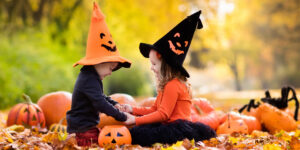 What’s particularly interesting is that America is a predominantly Protestant country, so it stripped away all the Catholic, British, and Celtic roots, and later, when Irish immigrants arrived in America, they redefined the original holiday. The Halloween we know today began to take shape in the 19th and 20th centuries and by the 1950s, it had become an established holiday with traditions such as trick-or-treating, dressing up, pumpkin carving, corn mazes, and haunted houses
What’s particularly interesting is that America is a predominantly Protestant country, so it stripped away all the Catholic, British, and Celtic roots, and later, when Irish immigrants arrived in America, they redefined the original holiday. The Halloween we know today began to take shape in the 19th and 20th centuries and by the 1950s, it had become an established holiday with traditions such as trick-or-treating, dressing up, pumpkin carving, corn mazes, and haunted houses
Midautumn festival (中秋節)
After the United States lets go to the far east, to China. In China, during the fall equinox they celebrate the midautumn festival. The star of this holiday is the full moon, which is the roundest around this time.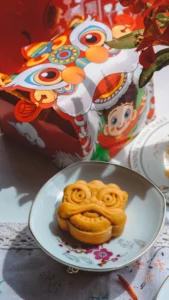
And this roundness also simbolize the unity of the family. During this time, everyone is going to their hometowns. And the crucial point of this celebration is the mooncake. Mooncake is a special round pastry, filled whit salty or sweet filling. Everyone eats this with their family during the holidays, and its simbolize the reunification of the family. In ancient times people only can rely on the sky, moon, sun and the stars for navigation, and to tell the passing time. So it was crucial for agricultural societies to rely on the sky, for the timing of the agricultural works. Thats why the harvest and the equinox cant be separated. They need to be finish up the harvest and start to prepare for the winter by then. The holiday can be traced back to the Shang Dinasty (1600-1045 BC) They celebrated the equinox, and made a sacrifice to the Moon. In China they respect the Moon goddes during this time. This is the story of The Moon goddes who is called Chang’E : She was the wife of a mitological king, but she drank the potion of eternal life, however she coudnt live eternaly, here in earth, so she moved to the moon.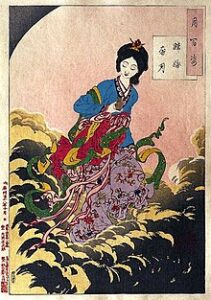 Thats why they also celebrate beauty, youth and love whit this holiday. The order of the meals are also changing at this nigth. In the east they usualy dont eat their meals at dishes, they eat at once, however at the midautumn festival, they eat the dishes separetly, one after the other. This simbolise the countinous food suply during the year. And if you are visiting your family for the festival, its polite to leave some food ont he plate otherwise they can think that you remained hungry. At the end of the holiday meal, they cut a moon cake to as many pieces as the members of the family are. Usualy they cut a piece for the unborn children as well. At this time the family usualy gathers at the parents of the husband. And besides relatives, only the cloosest friends can be invited.
Thats why they also celebrate beauty, youth and love whit this holiday. The order of the meals are also changing at this nigth. In the east they usualy dont eat their meals at dishes, they eat at once, however at the midautumn festival, they eat the dishes separetly, one after the other. This simbolise the countinous food suply during the year. And if you are visiting your family for the festival, its polite to leave some food ont he plate otherwise they can think that you remained hungry. At the end of the holiday meal, they cut a moon cake to as many pieces as the members of the family are. Usualy they cut a piece for the unborn children as well. At this time the family usualy gathers at the parents of the husband. And besides relatives, only the cloosest friends can be invited.
Sukkot and Rosh Hashanah
So countinue our journey whit the jewish traditions. The jewish celebrations can be devided in two groups, the spring festivities and the autumn festivities. The spring celebrations has more of a lamenting and historcal nature. This celebrations are also representing the life and work of Christ for the christians, like Easter and Pentecost. While the autumn festivities are more about the future and prophecies for them. But all the holidays, in general, has many layers and even if i cant show them all, i like to give a fuller perspective.
While, as i said, the spring holidays has their christian pairs, whit easter and the pentecost, the autumn holiday only has some prophetic meaning for the christians. Its also worth to mention, that in the jewish culture every holiday and every custum are connected and has a deep connection whit eacother. So the holidays are aslo had a pair. This time is the start of the jewish new year, the head of the year, Rosh Hashanah. This is the start of a seven day long celebration.
The autumn celebrations starts whit Jom Kippur in september, this is the day of forgivness when God forgave the jews after worshipping the golden bull. Jom Kippur is the shabbat of shabbats, you have to stop everything you do, for this day. Then the celebration countinous whit Sukkot. This is the holiday of the tents when they remember the 40 years spent in the desert. After this at october they celebrate the day when God gave the Torah. After That they celebrate new year in october.
 These celebrations starts in september and countinue thru out october. The Sukkot is the celbration of celebrations, in the Bible, it is called simply the holiday. During this time people gathering in tents, they eat, drink and have guests in there. With this, they remeber the 40 years of peregrination in the desert. But this is at the same time when harvest is, so its also a harvest festival. They celebrate the fresh harvest and give thanks for it. Sincet he rainy season starts soon after. The tent is also can be seen as a harvest tent.
These celebrations starts in september and countinue thru out october. The Sukkot is the celbration of celebrations, in the Bible, it is called simply the holiday. During this time people gathering in tents, they eat, drink and have guests in there. With this, they remeber the 40 years of peregrination in the desert. But this is at the same time when harvest is, so its also a harvest festival. They celebrate the fresh harvest and give thanks for it. Sincet he rainy season starts soon after. The tent is also can be seen as a harvest tent.
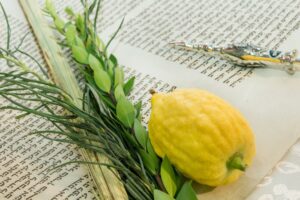 An important aspect of this holiday is, to bring people out of the pride of the harvest and their well-being. During the nigths, that they spend under the stars they can reflect together to the year that has passed. The Etrog (a mediterranian lemon like fruit) and the palm leaves are important simbols of this holiday, they represent the harvest. The Sukkot is a seven day long holiday but only the firts and the last days are full holidays.
An important aspect of this holiday is, to bring people out of the pride of the harvest and their well-being. During the nigths, that they spend under the stars they can reflect together to the year that has passed. The Etrog (a mediterranian lemon like fruit) and the palm leaves are important simbols of this holiday, they represent the harvest. The Sukkot is a seven day long holiday but only the firts and the last days are full holidays.
Chuseok (추석)
Finaly i like to close my blog post in Korea. There they celebrate the holiday of Chuseok similar then the midautumn festival in China.
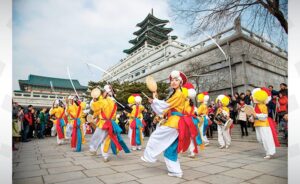 The word Chuseok means the 15th day of august, but accoding to the gregorian calendar ist always fall on a later date. usualy peope go to their hometown as well as in China. They even needs to put up signs for foreigners, to not travell in the highways during this time, because there are always huge traffic jams. woman has to do offerings from the fresh rice and fruit harvest to the deceased. besides that, here they also eat a special cake, made whit rice flour and sesame and redbean paste. As they steam the cakes, they put pine tree leafs next to them, so the whole house has this nice pine tree aroma. The family gathers at the nigth of Chuseok and make those cakes togather. Gifting is also a big part of the holiday. Usualy they give little gifts for friends and family. The most popular gift is smack meat, but they also like to give fruits, shampoo or sweets.
The word Chuseok means the 15th day of august, but accoding to the gregorian calendar ist always fall on a later date. usualy peope go to their hometown as well as in China. They even needs to put up signs for foreigners, to not travell in the highways during this time, because there are always huge traffic jams. woman has to do offerings from the fresh rice and fruit harvest to the deceased. besides that, here they also eat a special cake, made whit rice flour and sesame and redbean paste. As they steam the cakes, they put pine tree leafs next to them, so the whole house has this nice pine tree aroma. The family gathers at the nigth of Chuseok and make those cakes togather. Gifting is also a big part of the holiday. Usualy they give little gifts for friends and family. The most popular gift is smack meat, but they also like to give fruits, shampoo or sweets.
Summary
So, all in all, we can say that in most parts of the world, there are celebrations in some way or another during one of the three months of autumn. These holidays almost always serve to mark the end of the harvest, celebrate it, and welcome the beginning of winter.
 The moon and the autumnal equinox are inseparable from nearly all autumn festivals. This period is a time for family, thanksgiving, and feasting worldwide. With that, I would like to conclude this brief overview. If anyone is still interested in the topic or perhaps looking for a good book to cozy up with during this season, we warmly welcome you to our library. And we hope that these lines have brought a smile to the faces of our international students at the university.
The moon and the autumnal equinox are inseparable from nearly all autumn festivals. This period is a time for family, thanksgiving, and feasting worldwide. With that, I would like to conclude this brief overview. If anyone is still interested in the topic or perhaps looking for a good book to cozy up with during this season, we warmly welcome you to our library. And we hope that these lines have brought a smile to the faces of our international students at the university.
And at least i like to leave here a brief bibliography from our books in the library that are about this topic. I got my inspiration from those books as well, so if you like, you can read those or more.
Babits Antal: Zsidó Ünnepek =Jewish holidays = Jüdische Feste
Jane M. Hatch: American book of days
Krythte Maymie Richardson: All About American Holidays
Kenneth Scott Latourette: A histoty of modern China
Lee Kyung Hee: World Heritage In Korea


Leave a Reply